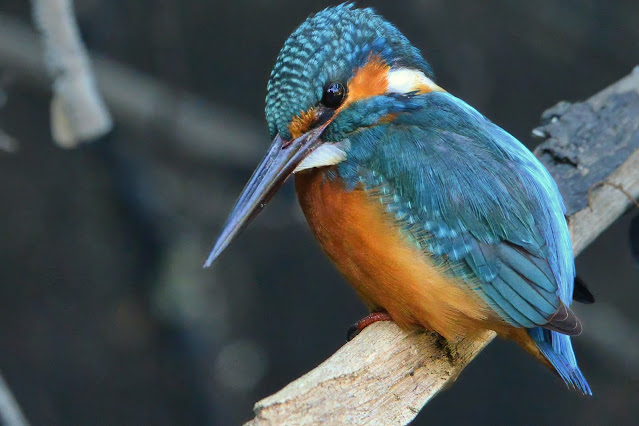Giant Golden Orb Weaver (Nephila pilipes) - Birds And More 015
Birds And More 015 - Giant Golden Orb Weaver (Nephila pilipes)
Birds are the point of focus when walking in the woods. Listening to their calls and songs amid the sound of wind through the trees, the song of water flowing through the stream, and the warning calls of squirrels make these walks ever special. To be honest, I hardly focused on butterflies, insects, and spiders before meeting Samarth Jain during my visit to Jabalpur in October 2023. He is a zoology student aspiring to be a conservationist. While he was aware of the calls of the birds while we were talking, I was impressed with his knowledge and awareness of butterflies and other insects. He kept on pointing at one or another little creature that I hardly noticed. Having said that, I noticed Giant Golden Orb Weaver (Nephila pilipes), you can't miss them but didn't know much about them. Samarth told me everything about them starting from their scientific name to their mating, food, and massive webs that can last for not days, weeks, or months but years.
.jpg) |
| Male & Female Giant Golden Orb Weaver (Nephila pilipes) with me in the background Devtaal, Jabalpur October 2023 |
Giant Golden Orb Weaver (Nephila pilipes) are known for their impressive size and sexual dimorphism, with females reaching up to 20 centimeters (8 inches) in leg span and males being much smaller, around 5 millimeters (0.2 inches) in body length. I was spellbound by the size, elaborate web, and behavior of males. Initially, I thought they were newly hatched, but Samarth told me that multiple males compete to mate with the female and she mates with more than one partner. The the picture below, you can see 3 males on the web.
 |
| 3 Males & Female Giant Golden Orb Weaver (Nephila pilipes) with me in the background Devtaal, Jabalpur October 2023 |
Gigantism and Dwarfism, both are known to take place in the course of evolution. In these spiders, both took place. The females, in order to find a way around 'Plugging' (an act of sealing the female genitilia by the male after mating), grew big, so that the plugs could be loosened. The males, however, realised that they would have a better chance of reaching a ready female, if they were fitter, faster, and by logic, smaller, as compared to large clumsy males. Females grew big, and males grew smaller, leading to a most disproportionate couple on terra ferma. (notes from Manish Hariprasad @manishariprasad)
There are many species of nephila around the world, often referred to as golden orb-weavers or giant wood spiders. The genus name nephila in Ancient Greek means "fond of spinning". Giant webs of these spiders could indeed span as big as 2 meters in diameter. Their silk is incredibly strong and elastic, making it suitable for capturing a variety of prey, including insects, small vertebrates, and even bats. While I was taking pictures of these amazing spiders, I saw how intricately a female consumes one of its prey a wasp or bee (pictured below).
.jpg) |
| Web of Female Giant Golden Orb Weaver (Nephila pilipes) with a prey Devtaal, Jabalpur October 2023 |
.jpg) |
| Female Giant Golden Orb Weaver (Nephila pilipes) with a prey Devtaal, Jabalpur October 2023 |
As I was struggling to get the right focus and white balance for my picture, Ashish Pandey, another friend I made during this visit, helped me with the setting in my Nikon that I never used in the past. The results were amazing. Ashish is an optics engineer, highly skilled photographer, and birder.
 |
| Male & Female Giant Golden Orb Weaver (Nephila pilipes) with me in the background picture credit: Ashish Pandey Devtaal, Jabalpur October 2023 |
Giant Golden Orb Weaver (Nephila pilipes) have special sticky webs and a passive hunters waiting for prey to become entangled. Their vibration-sensing abilities are amazing, allowing them to detect even the slightest movement in their webs. Once prey is trapped, the spider quickly injects venom and wraps it in silk for later consumption.
.jpg) |
| Female Giant Golden Orb Weaver (Nephila pilipes) with a prey Devtaal, Jabalpur October 2023 |
As mentioned above, Giant Golden Orb Weaver (Nephila pilipes) exhibit a mating system where multiple males can mate with a single female. After mating, females lay large, round egg sacs that are attached to leaves or other structures near their webs. The eggs develop within the sac. These spiders are widely distributed across tropical and subtropical regions worldwide, inhabiting various environments such as forests, grasslands, and even urban areas. They are commonly found in vegetation, often hanging from branches or tree trunks.
Giant Golden Orb Weaver (Nephila pilipes) have held cultural significance in various societies throughout history. In some cultures, they are revered as symbols of strength and resilience, while in others, they are associated with fear and mystery. They play a crucial role in maintaining the balance of their ecosystems by helping to control insect populations. They are also an important food source for various predators, such as birds, lizards, and wasps.
The spiders, butterflies, and insects inspired me to take a pause and look around for everything that is around us. I am not discarding my old camera now, I will carry it with a Marco lens whenever I am out and about.
.jpg)
.jpg)
.jpg)

.jpg)
Comments
Post a Comment